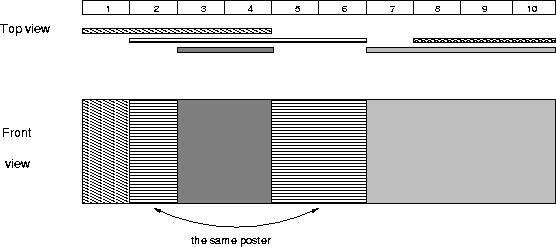POJ 2528 Mayor's posters(线段树区间离散化入门)
Description
- Every candidate can place exactly one poster on the wall.
- All posters are of the same height equal to the height of the wall; the width of a poster can be any integer number of bytes (byte is the unit of length in Bytetown).
- The wall is divided into segments and the width of each segment is one byte.
- Each poster must completely cover a contiguous number of wall segments.
They have built a wall 10000000 bytes long (such that there is enough place for all candidates). When the electoral campaign was restarted, the candidates were placing their posters on the wall and their posters differed widely in width. Moreover, the candidates started placing their posters on wall segments already occupied by other posters. Everyone in Bytetown was curious whose posters will be visible (entirely or in part) on the last day before elections.
Your task is to find the number of visible posters when all the posters are placed given the information about posters' size, their place and order of placement on the electoral wall.
Input
Output
The picture below illustrates the case of the sample input.

Sample Input
1 5 1 4 2 6 8 10 3 4 7 10
Sample Output
4
第一次写线段树离散化的题,记录下学习感受(主要是个人对于离散化的理解):
此题很显然的线段树的题目,但是区间的大小有10^7那么大,正常写必然MLE(同时也是TLE)
但是其实如果区间只有2个分别是[1,999]和[200,9999],我们可以将区间换成[1,3][2,4]
为什么可以这样?这是怎么转换的?不会出问题吗?
于是引入了离散化:
离散化我的理解是 有些数据本身很大,无法直接作为数组下标保存对应的属性
如果此时只需要用到这堆数据的相对属性,而与具体数值无关的时候,可以利用离散化将数据缩小
举个简单栗子:如果有一堆很大的数据,而我只是需要比较它们的大小而不需要考虑它们真实的值,那么
123 、1234 、1234、12345 、12356 这堆数可以用 1、2、2、3、4代替,
因为我需要的性质(123 < 1234 = 1234 < 12345 < 123456)
被保存下来了(1<2=2<3<4)
显然,离散化的特点是数据更小,但是它最关键的条件是:数据的相对属性不变(而且是你只用到相对属性而不用数据的具体数值,或者如果两者都需要用可以自己想办法进行2种保存)
上面的例子并不很生动,于是我们开始以线段树的区间离散化为例:
首先,就这题而言,我们只需要区间的相对属性,而不需要区间的具体长度(这是显然的)
所谓区间的相对属性,主要就是各个区间之间的关系了,包含?交?并?
比如之前举的[1,999]和[200,9999]这两个区间是‘交’的关系,于是我们将它化为[1,3][2,4]也能体现其交的关系
再比如[1,1000]和[5,999]这两个区间可以离散化成[1,4][2,3]
如果是[1,1000][1001,2000]则离散化成[1,2][3,4]
而如果是[1,1000][1000,2000]则离散化成[1,2][2,3](端点相等的性质也要体现出来)
这样就大概懂了什么是离散化了,那么具体怎么操作呢?区间那么多,要怎么离散才能保证所有区间的性质都不变?
这个我想了好久,什么DP、BFS、DFS、各种处理方法瞎想,后来看了大牛的博客才发现处理方法居然那么简单!!!(怪我傻。)
还是[1,999]和[200,9999]这个简单的例子,我们将区间的端点单独拿出来看(从小到大),就是4个数:1,200,999,9999
然后我们将这四个数离散成:1,2,3,4 之后再放回原来的区间,就成了[1,3][2,4]
接下来对样例进行离散化:
原区间:[1,4][2,6][8,10][3,4][7,10]
取数据: 1 2 3 4 4 6 7 8 10 10
离散化: 1 2 3 4 4 5 6 7 8 8
后来的区间: [1,4][2,5][7,8][3,4][6,8]
注意之前提到过的区间端点相等的性质也需要保存
为了单独取出区间端点,我们需要保存该端点是属于哪个区间,是左端点还是右端点,于是开这样一个结构体:
struct Seg
{
int num;//保存一个端点
int pos;//记录是第几个区间
bool w;//记录是区间的左端点还是右端点,左0右1
}ol[2*N+5];
bool cmp(Seg a,Seg b)//端点排序方便后来离散化处理
{
return a.num < b.num;
}
很显然有N个区间就有2*N个端点
离散化之后的区间我又开了一个结构体保存。。。(毕竟第一次玩离散化。。。还太渣。。。)
struct QU
{
int l,r;//原数据离散化后的新区间
}op[N+5];下面是离散化的具体过程:
for (int i = 1,l,r;i <= n;++i)
{
scanf("%d %d",&l,&r);
ol[++k].num = l,ol[k].pos = i,ol[k].w = 0;
ol[++k].num = r,ol[k].pos = i,ol[k].w = 1;
}
/******************************离散化*************************/
sort(ol+1,ol+k+1,cmp);
if (ol[1].w) op[ol[1].pos].r = 1;
else op[ol[1].pos].l = 1;//离散化后最小的数化为1
int x = 1;
for (int i = 2;i <= k;++i)
{
if (ol[i].num == ol[i-1].num)//离散后区间性质不能变
{
if (ol[i].w) op[ol[i].pos].r = x;
else op[ol[i].pos].l = x;
}
else //因为前面排序了,这里只有可能ol[i].num < ol[i-1].num
{
x++;//比前一个数大一就可以满足‘大’这个性质
if (ol[i].w) op[ol[i].pos].r = x;
else op[ol[i].pos].l = x;
}
}
离散化完了就是正常的线段树了,直接上AC代码:
#pragma comment(linker, "/STACK:1024000000,1024000000")
#include<iostream>
#include<cstdio>
#include<cstring>
#include<string>
#include<algorithm>
#include<queue>
#include<cmath>
#include<stdlib.h>
#include<cctype>
#include<map>
#define mem(a,x) memset(a,x,sizeof(a))
#define esp 1e-8
using namespace std;
typedef long long ll;
const int dx[] = {-1,1,0,0};
const int dy[] = {0,0,-1,1};
const int inf = 1<<29;
const int N = 10000;
struct Seg
{
int num;//保存一个端点
int pos;//记录是第几个区间
bool w;//记录是区间的左端点还是右端点,左0右1
}ol[2*N+5];
bool cmp(Seg a,Seg b)//端点排序方便后来离散化处理
{
return a.num < b.num;
}
struct QU
{
int l,r;//原数据离散化后的新区间
}op[N+5];
const int NN = 200000;//离散化后的数据上限2*N
struct Node
{
int l,r;
int k;
}q[4*NN];
bool vis[NN+5];
void build(int i,int l,int r)
{
q[i].l = l,q[i].r = r;q[i].k = 0;
if (l == r)
{
return ;
}
int mid = (l+r)>>1;
build(i<<1,l,mid);
build((i<<1)+1,mid+1,r);
}
void update(int i,int l,int r,int k)
{
if (q[i].l ==l && r == q[i].r)
{
q[i].k = k;//该区间贴上第k个人
return ;
}
if (q[i].k > 0&&q[i].k != k)
{
q[i<<1].k = q[i].k;
q[(i<<1)+1].k = q[i].k;
q[i].k = 0;
}
int mid = (q[i].l + q[i].r)>>1;
if (r <= mid) update(i<<1,l,r,k);
else if (l > mid) update((i<<1)+1,l,r,k);
else
{
update(i<<1,l,mid,k);
update((i<<1)+1,mid+1,r,k);
}
}
int sun;
void Cal(int i)
{
if (q[i].k)//找到该区间贴的人编号
{
if (!vis[q[i].k])//如果这个人没有算过
{
// cout<<"区间["<<q[i].l<<","<<q[i].r<<"]贴着第"<<q[i].k<<"个人"<<endl;
vis[q[i].k] = 1;
sun++;
}
return;
}
Cal(i<<1);
Cal((i<<1)+1);
}
int main()
{
int T;scanf("%d",&T);
while (T--)
{
int n;
scanf("%d",&n);
int k = 0;
for (int i = 1,l,r;i <= n;++i)
{
scanf("%d %d",&l,&r);
ol[++k].num = l,ol[k].pos = i,ol[k].w = 0;
ol[++k].num = r,ol[k].pos = i,ol[k].w = 1;
}
/******************************离散化*************************/
sort(ol+1,ol+k+1,cmp);
if (ol[1].w) op[ol[1].pos].r = 1;
else op[ol[1].pos].l = 1;//离散化后最小的数化为1
int x = 1;
for (int i = 2;i <= k;++i)
{
if (ol[i].num == ol[i-1].num)//离散后区间性质不能变
{
if (ol[i].w) op[ol[i].pos].r = x;
else op[ol[i].pos].l = x;
}
else //因为前面排序了,这里只有可能ol[i].num < ol[i-1].num
{
x++;//比前一个数大一就可以满足‘大’这个性质
if (ol[i].w) op[ol[i].pos].r = x;
else op[ol[i].pos].l = x;
}
}
/***************************线段树**************************/
build(1,1,x);//刚刚的离散化使数据上限变成x
mem(vis,0);sun = 0;
for (int i = 1;i <= n;++i)//贴海报
{
update(1,op[i].l,op[i].r,i);
}Cal(1);//计算
printf("%d\n",sun);
}
return 0;
}
第一次玩离散化,如有理解错误的地方,望指出,O(∩_∩)O谢谢~